by Heather Plett | Apr 19, 2016 | journey, Spirituality, Wisdom
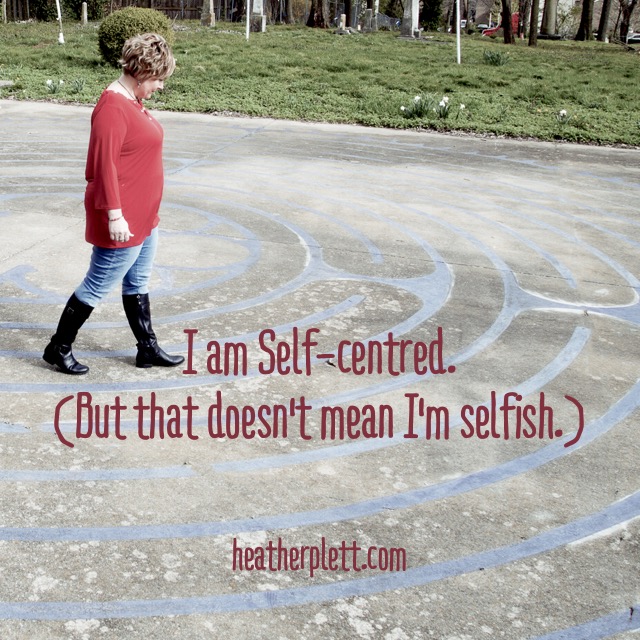
Growing up in a Mennonite home, where self-sacrifice was one of the highest goods, I was convinced that self-centredness was one of the seven deadly sins.
But as I near my fiftieth year on the planet, I’m learning to be Self-centred, and I’m no longer convinced that’s wrong.
This afternoon, after spending many hours gathering all of the tidbits of my business finances together to bring to the accountant for tax preparation (I’m a disorganized business person), I decided to take advantage of the beautiful Spring weather and go to the park. King’s Park, which houses the labyrinth I love, is one of my favourite places to welcome Spring because the two harbingers of Spring on the prairies – crocuses and frogs – can be found there.
Not surprisingly, the old stories came up on the way there. “Your tax bill is going to be high this year – you should be working so you can afford to pay it.” “If you’re not working at your business, you should at least be cleaning the house. Have you looked at the kitchen floor lately? Disgusting.” “If you’re not cleaning or working on your business, shouldn’t you be giving up your free time for a friend who needs you?”
And then the biggie…
“You are being self-centred.”
I smiled at the voices and let them play through their stories in my head, and then I went to the park anyway. I know they mean me no harm – they are there to protect me – and I also know that giving them the upper hand will keep my life small and unhappy. Time in the sunshine is not something I feel guilty about, especially when the taxes are done.
I walked the labyrinth, not in a slow and meditative way, but in a curious and attentive way, watching for the fuzzy heads of crocuses popping up between the paths. The crocuses weren’t quite ready to bloom, but I was rewarded for my attentiveness with a frog who let me get close enough to take a picture.
As I neared the centre of the labyrinth, a new thought popped into my head…
Perhaps it’s a good thing to be Self-centred.
What if, instead of interpreting self-centred as selfish, we interpret it as “keeping your Self at the centre”?
I capitalize Self here, because I’m referring to the spiritual Self, the higher Self, the one that seeks wholeness within a deep relationship with God/dess.
When we walk the labyrinth, we pause at the centre, because that is where we are most in touch with our Self. That is where we rest in openness, ready to receive Spirit. That is where we are most emptied of ego and fear and the false stories that keep us small.
The labyrinth teaches us to be Self-centred.
Paradoxically, a Self-centred life is actually less selfish than an other-centred life, because we don’t rely on others to fulfill us or make us happy. We don’t place unrealistic expectations on others to define us or behave a certain way. We allow others their own happiness without placing obligations on them to make us happy. We give out of our fullness rather than out of our neediness. We are at peace and therefore we create an environment where others can be at peace too.
When we are Self-centred, we do our own work and don’t expect others to fix us.
When we are Self-centred, we detach ourselves from other people’s behaviour and give them the freedom to find their own paths to their own Selves.
When we are Self-centred we find out who we truly are and we no longer rely on other people’s definition of us.
When we are Self-centred, we serve other people out of our delight in them and not out of obligation or need.
When we are Self-centred, we can offer and receive unconditional love.
When we are Self-centred, we can live in community and not expect that community to give us everything we need.
When we are Self-centred, we hold space for our Selves and that allows us to hold space for others without losing ourselves in them.
One month from tomorrow, I’ll turn 50. As I near that milestone, I’m making it my goal to become more Self-centred.
********
If you want to be more Self-centred, a journey through The Spiral Path or Mandala Discovery might help.
Interested in more articles like this? Add your name to my email list and you’ll receive a free ebook, A Path to Connection and my weekly reflections.
by Heather Plett | Sep 9, 2015 | circle, growth, journey, Labyrinth
 This week, school is back in session. One of my daughters started today and the other two start tomorrow. Two are now in university and one is in grade 8, her last year before high school.
This week, school is back in session. One of my daughters started today and the other two start tomorrow. Two are now in university and one is in grade 8, her last year before high school.
I can say all of the clichéd things, and mean them… My how time flies! Wasn’t it just yesterday I was changing their diapers? How did it all rush past in the blink of an eye?
The return to school always reminds me of the relentless and dependable forward motion of time. Tick, tick, tick goes the clock. Flip, flip, flip go the pages of the calendar.
Today I was rushing out for last minute school supplies, haircut appointments, musical instrument rental, etc., and in the middle of it all, I wanted to hit the pause button. I wanted to slow down the pace of time, enjoy a few more summer days, and cling to my daughters’ fleeting childhood before it all disappears.
From my daughters’ perspective, still in their formative years, this is the way life is supposed to be lived – growing each year, advancing one grade after the other, stepping always forward on the straight line of time guided by the clock and the calendar. It’s the way we’re all raised – to believe that there is always meant to be forward movement. That’s not a bad thing – we want growth to happen.
But that’s only part of the truth and there’s something else I really want my daughters to learn that they probably won’t be taught in school.
Life is to be lived along the spiral and not simply the straight line.
When I was at the beach this summer, working on my book, I spent a lot of time watching pelicans. One of the things I love about pelicans is that, often, they fly across the sky in giant spirals, round and round, adjusting the arc of the spiral just enough each time so that they end at the far side of the sky from where they started.
They do this to conserve energy, riding thermals (updrafts of warm air that rise from the ground into the air), so they don’t have to flap their wings as often. They look so content and relaxed up there, circling round and round with very little effort on their part. High in the sky, they look like mythical creatures, as if they’d climbed out of ancient legends of magicians and shamans. Their shape and the way they move holds both mystery and myth.
That’s the path that I have come to believe is the most true way of seeing our lives. We go round and round, coming back each time to nearly the same place we’ve been, but always with enough of a difference to help us progress forward over time.
How many times have you been in this place you’re at right now? Like the seasons, our lives come back again and again to the harvest of Fall, the dormancy of Winter, the rebirth of Spring, and the growth of Summer. And, like the seasons, we live through the long dark spells, the slow sunny days, the rain, the wind, and the snow. We cycle through grief, through growth, through joy, through surrender, and through ease.
None of the seasons lasts forever. All of them change us a little before we begin the spiral again.
If you are in a place you feel like you’ve been before – whether it’s another cycle through grief, restlessness, waiting, or fear – don’t despair. You’re simply spiralling through the sky, learning what you need to from this trip around the circle, and moving a little further each time.
If you were traveling up a mountain, you’d be best to take the spiralling path, adjusting to the altitude, not tiring yourself out too quickly. Like the pelicans floating on the thermal air, you conserve your energy by not rushing straight ahead. You also learn more and see more that way. This is the way life is meant to be lived.
Don’t rush through, even though the path might seem hard right now. Take what you need from this time, and let it unfold in the fullness of time.
If you want to take a closer look at your own spiral path, I invite you to join us for the October offering of The Spiral Path: A Woman’s Journey to Herself.
Interested in more articles like this? Add your name to my email list and you’ll receive a free ebook, A Path to Connection. I send out weekly newsletters and updates on my work.
by Heather Plett | Jan 17, 2015 | Labyrinth, Spirituality, Uncategorized
 “Release, receive, and return.” That’s what the labyrinth invites us to do.
“Release, receive, and return.” That’s what the labyrinth invites us to do.
Yesterday, I needed to release, receive, and return. I was stressing out about the ongoing tension between “do the thing that brings in money” and “do the thing that’s calling you next” – the ever-present question of all soulful entrepreneurs.
I wanted to go to the labyrinth, but it’s covered in snow, so I did the next best thing… I made a finger labyrinth. It turns out that making a labyrinth is almost as good as walking one for that whole “release, receive, and return thing.”
Since I use labyrinths a lot in my work (especially The Spiral Path, which is a 21 lesson journey through the labyrinth to your authentic heart), I thought I’d share the steps in making my finger labyrinth in case you’d like to make one too.
You’ll need:
- a square canvas or piece of wood (I used an 11X11″ canvas)
- a print out of your favourite labyrinth design, printed to the scale of the canvas (For an 11X11 canvas in the 7 path Chartres design that I made, here’s a pdf that prints on two 8.5X11 pieces of paper. If you prefer a different design, just Google “labyrinth template”)
- heavy string
- glue (I used a hot glue gun and white glue, but if you don’t have a glue gun, white glue is fine)
- newsprint or other paper (whatever you use should be fairly thin)
- mod podge (or just use gel medium)
- gel medium
- acrylic paint
Step 1. Print the labyrinth design and glue it onto the canvas or board. I used ordinary white glue, spread thin with a spreader (any straight plastic edge, like an old credit card) will work. Use the spreader to work out any bubbles in the paper (though it doesn’t have to be too fussy, since you’ll cover it).
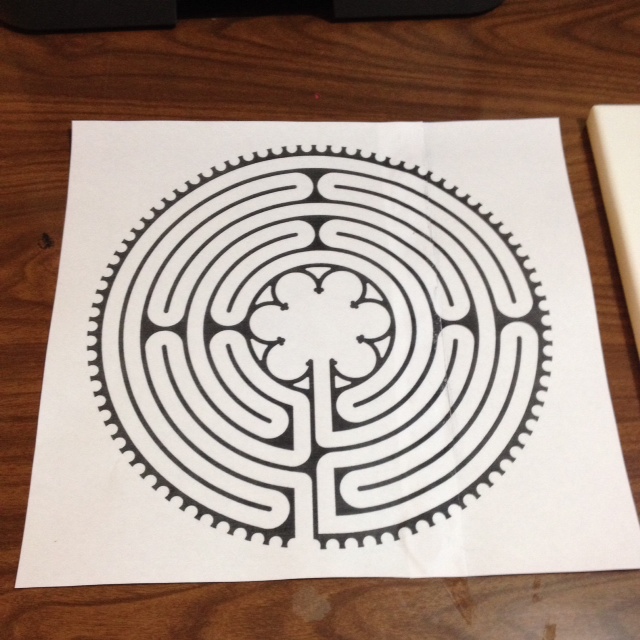
Step #2. Glue heavy string onto all of the black lines. I used the hot glue gun for this because it dries faster, but it would work fine with white glue.
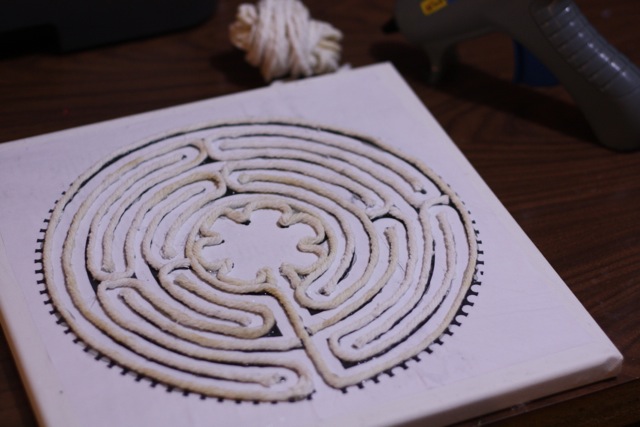
Step #3. Cut lots of short strips of newsprint. I used blank newsprint, because it’s easier to paint over, but you could use newspaper. You could also use coloured paper if you don’t want to paint it. Tissue paper would also work, but you’d need a few layers to make sure the black is covered. The strips I used were approx. .75″ by 3″. You don’t have to be fussy about it, but you’ll want them wide enough to cover the string and adhere to the surface without covering two lines of string at the same time.
Step #4. Slather mod podge (or gel medium) generously on a section of string. Add a strip of paper and cover the paper with more mod podge (or gel medium). The best way to do this is with your fingers, so be prepared to get a little messy.
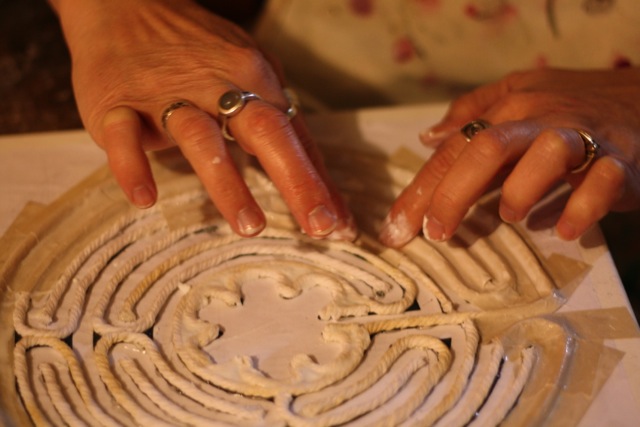
Step #5. Keep going until you have the whole labyrinth and canvas covered with strips of paper. Some spots are tricky (especially if you decide to do the flower pattern at the centre, like I did), so you’ll have to let go of your inner perfectionist and let it be a little imperfect. Make sure it’s all well coated with mod podge (or gel medium). Let it dry.

Step #6. If you want to paint it, add a layer of gel medium once it’s dry (this time you can do it with a paint brush) to smooth out some of the rough edges and to make sure the paint adheres to the surface.
Step #7. Paint it however you like. I used three tones of acrylic paint for the ombre effect (crimson, burnt sienna and ochre.
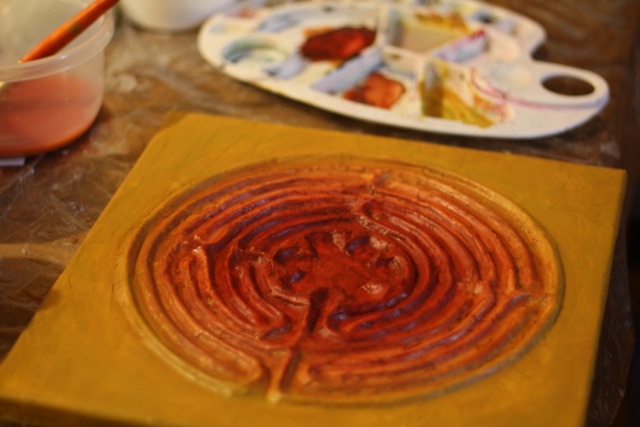
Step #8. If you want to give it a more textured, aged effect, rub a glaze over it. I used a brown glaze (acrylic paint mixed with gel medium) and rubbed it on with your fingers. Because I’d layered on the gel medium a little too thick, there were some cracks and the dark glazed picked these up, giving it a bit more of an aged look.
Step #9. Hang it on your wall or keep it in your studio, bedroom, or sanctuary where you can use it as a meditation tool.
Here are some tips for using your finger labyrinth…
- Before you start, take some time to settle in to a position in which you’re comfortable. Take some slow deep breaths to centre you in your practice.
- You may want to journal before and/or after the practice.
- Before you begin, you may wish to set an intention or ask a question that you will carry with you into the labyrinth, but be careful to keep it open-ended so that you’re open to surprise.
- Say a prayer, if you like, for support, healing, and guidance.
- Place a finger at the entrance of the labyrinth. Some people suggest that you use your non-dominant hand, as research suggests that our non-dominant hand has easier access to our intuition.
- As you follow the path with your finger inward, be conscious and intentional about releasing whatever stresses, worries, or distractions you might be feeling. Breathe deeply and slowly.
- Pause whenever you want, but don’t lift your finger off the labyrinth.
- When distracting thoughts come up, simply let them pass and wish them well as they leave your mind.
- When you reach the centre, pause for awhile and receive. Be open to whatever guidance and wisdom you may need, even if it’s not what you expected.
- When you’re ready, follow the path outward, consciously returning and bringing the wisdom of the centre out into your life with you.
- In your journal, write or sketch anything that came to you while you made the journey.
- Don’t try too hard. Sometimes the wisdom of the labyrinth is simply the pause that it forces you to take. Sometimes nothing obvious shows up, but that doesn’t mean it wasn’t time well spent. Stay open and receptive.
Starting February 1, 2015, you can join me in a 21 lesson journey through the labyrinth, back to your authentic heart in The Spiral Path: A Woman’s Journey to Herself. In the first seven lessons, you’ll release what no longer serves you. In the next seven lessons, you’ll open yourself to receiving. In the final seven lessons, you’ll return from the journey.
by Heather Plett | Jan 15, 2015 | calling, change, Let go of the ground, Uncategorized
“Something is shifting in my life. I feel lost. Everything I once depended on and believed in feels unstable and unreliable. I don’t know who I am anymore.”
I hear some version of this story almost every week in my coaching work. Somewhere in the middle of their lives, women (and men, though I hear fewer of those stories) go through a period of transition when their world shifts and the ground feels wobbly under their feet. They’ve left behind an old story but haven’t found themselves in the new story yet. They don’t know how to define themselves anymore and they’re not even sure they have much value.
The stories are almost always accompanied with tears and some measure of shame. They think they’re doing it wrong. They think everyone else has it figured out. They think there’s supposed to be a straight path between the old story and the new story. Or they think they were foolish and selfish for no longer being satisfied with the old story that once felt comfortable.
They’ve been fed a false narrative.
While still in high school, they were told that they’re supposed to figure out “what they want to be when they’re older” and then they’re supposed to follow a straight path to the “American dream.” They’re pretty sure that means that once they’re forty, they should have everything figured out and the question that once plagued them will have all been answered or at least have faded in importance.
But once they get to a midlife point, they realize that the questions are getting bigger and more urgent. They don’t know what to believe anymore. They don’t really know who they are. They don’t understand the meaning of their lives. They discover that motherhood, or their career, or the book they got published, or the dream they brought to fruition doesn’t satisfy them as much as they’d hoped. They’re feeling empty and lost, like a boat adrift at sea.
It’s such a common story that if I had a dollar for every time I’ve heard it, I could go on a very lovely vacation to the Caribbean.
The first thing I do when I hear this story is give them permission to cry and feel the grief. The second thing I do is tell them “This is where you’re supposed to be. This is a woman’s journey. You have to give yourself permission to be lost for awhile. It’s the only way you’ll find the path to your more authentic self.”
We all need to go through the empty place in order to connect with our deeper selves.
Every woman I know who has found her way into a deepened wisdom and a deeper sense of calling has gone through the empty place between stories. They’ve all found themselves adrift at sea somewhere in the middle of their lives, where they had to let go of old paradigms, old belief systems, and old ways of defining themselves. It was only when they let go of the resistance and the need to “be productive” and “be successful” that they were able to sink into the deep stillness of the empty place between stories.
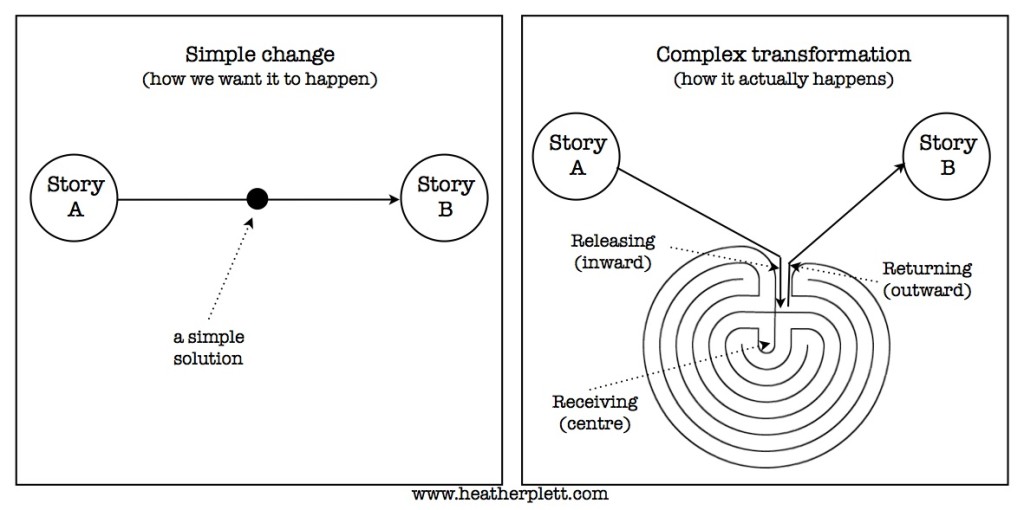
Nobody wants the complexity of real transformation.
The mess and the grief of letting go of the old story is scary and uncomfortable. We want the simple solution that many of the self-help books are selling us. We want ten easy bullet points.
But real transformation is more like the labyrinth. Real transformation invites us to step off the path into a complex, labyrinthine journey.
“Most of us arrive at a sense of self and vocation only after a long journey through alien lands. But this journey bears no resemblance to the trouble-free “travel packages” sold by the tourism industry. It is more akin to the ancient tradition of pilgrimage – ‘a transformative journey to a sacred centre’ full of hardships, darkness, and peril.” – Parker Palmer, Let your Life Speak
The labyrinth teaches us much about the journey through transition.
When we enter the labyrinth, we are invited to release. We let go of Story A. We let go of our expectations, our “American dream”, our comfort level.
Once we reach the centre, we are ready to receive. But our cups can only be filled up again if we reach that place empty and open. We’ve emptied ourselves of the old story so that the new story can begin to grow. At the centre, we receive guidance from Spirit, we receive grace, and we receive the strength we need to continue the journey.
When we are ready, we return. But we don’t go back to Story A. We return with the new story that has begun to grow at the centre. We return with a deeper connection to our authentic selves. We return ready to step into Story B.
What’s surprising, though, and always somewhat unsettling, is that Story B bears little resemblance to Story A. Story A fit into a much cleaner box. Story B has a lot of loose ends and a permeable border. Story A was black and white. Story B has a lot of complex shades of grey.
We are invited into a place of non-duality.
As Richard Rohr says in Falling Upward, the story for the second half of life is one of non-duality. When we are in a story of duality (the first half of our lives), we see the word in black and white, right and wrong, good and bad.
Rohr describes non-dual thinking as “our ability to read reality in a way that is not judgmental, in a way that is not exclusionary of the part that we don’t understand. When you don’t split everything up according to what you like and what you don’t like, you leave the moment open, you let it be what it is in itself, and you let it speak to you. Reality is not totally one, but it is not totally two, either! Stay with that necessary dilemma, and it can make you wise.”
Many people resist the invitation into Story B. They want to stay in a place where the world feels secure and safe. They hang onto a black and white world and they judge those who introduce them to shades of grey. Those people often become the fundamentalists who fight with all their might to resist change. They close themselves off in a box of self-preservation rather than step into a place of ambiguity.
But there is little value in hanging onto Story A when the new story wants to emerge. Your comfort will soon turn to bitterness, your safe home will become your prison.
Our world wants us to move, individually and collectively, into Story B.
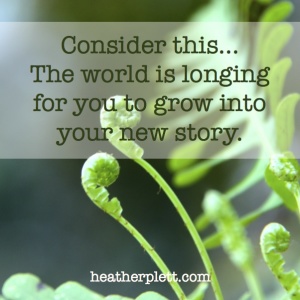 There are many thought leaders who believe that our world is in that empty place – the place of chaos – between Story A and Story B.
There are many thought leaders who believe that our world is in that empty place – the place of chaos – between Story A and Story B.
Yesterday, I participated in the first session of ULab, hosted by Otto Scharmer of MIT and Presencing Institute. On this MOOC (massive open online course) there are 25,000 people who are connecting to talk about the transformation of business, society, and self. We’re learning what it means to be in that “place of disruption” between stories. While on the webinar, thousands of us were tweeting from all over the world about what is ending and what is emerging. There’s a general consensus that the world can’t continue to function unless we step into a new story, a new way of connecting with ourselves, each other, and the world. But before getting to that new story, we have to let ourselves be lost for awhile.
In The More Beautiful World Our Hearts Know Is Possible, Charles Eisenstein talks about The Story of Separation that the world has been living in. That’s a story that keeps us locked in a financial economy that demands growth and the pillaging of the earth for the resources that feed that growth. It’s a story that has us living as separate, self-sufficient individuals instead of in community. It’s a story that requires a greater and greater investment in military actions that help us protect our resources and our self-sufficiency.
The new story that the world is longing for is a Story of Connection.
It’s a story that brings us back to a healthy relationship with each other and the earth. It’s a story of trust and compassion, community and spirituality.
As the diagram above shows, we won’t get to the Story of Connection until we are ready to release the Story of Separation, step into the centre of the labyrinth, and receive the new thing that wants to be born in each of us.
If you find yourself in that empty place between stories, know this – you are not alone. You are living a story that is playing itself out all over the world.
We are all trying to find our way into the new story. Some of us are desperately hanging onto the old story, some of us are ready to hospice the old story into its death, and some of us are ready to midwife the new story into its birth.
In the transformation from caterpillar to butterfly, there are a few cells, called imaginal cells, that hold the dream of the butterfly alive while all of the other cells see only the end of the world that was once their caterpillar life. Those imaginal cells lead the transformation into the new, more beautiful thing that is meant to emerge.
In my work, I am blessed to be in connection with many imaginal cells – people who sense the end of Story A has come and who believe that there is something new and better emerging. Perhaps you are one such cell.
Perhaps you have been invited into the difficult stage of transformation so that you can serve as a model for others coming after you.
I invite you to consider that whatever you are going through right now, you are going through something that is helping you emerge into the more beautiful world. And your transformation is part of the transformation of the world around you.
Step into the labyrinth. Let yourself be changed.
Need some support on this journey through transformation? Registration is now open for The Spiral Path: A Woman’s Journey to Herself. In this 21 lesson course, you’ll be guided through the three stages of the labyrinth journey.
by Heather Plett | Oct 14, 2014 | journey, Labyrinth, mandala, painting, Passion, Spirituality, Uncategorized
I often use labyrinths in my retreats and workshops, and until now I’ve either used what’s available onsite, or I’ve created them with string, mowed them into grass, or made them out of dried leaves.
This weekend, I finally made a portable labyrinth that I can carry with me.
 When I shared the result on social media, several people asked for details about how I made it. Here’s how:
When I shared the result on social media, several people asked for details about how I made it. Here’s how:
 1. Since canvas can be quite expensive, I looked for a less expensive alternative. At the local Home Depot, I found painting drop cloths that were 4′ x 20′. They worked well because they’re fabric on one side and plastic on the other so that they absorb the paint without soaking through to the floor. Plus they’re fairly light weight for easier transport. (They cost $22 each, so my total investment was $110, since I had all of the other materials on hand.)
1. Since canvas can be quite expensive, I looked for a less expensive alternative. At the local Home Depot, I found painting drop cloths that were 4′ x 20′. They worked well because they’re fabric on one side and plastic on the other so that they absorb the paint without soaking through to the floor. Plus they’re fairly light weight for easier transport. (They cost $22 each, so my total investment was $110, since I had all of the other materials on hand.)
2. I wanted to make my labyrinth approximately 20′ x 20′, so I bought 5 drop cloths and sewed them together. They’re hemmed along the long edges, and at first I was going to seam-rip all of the hems, but that was far too tedious, so I just cut off the hems (losing a bit of the width, but I was okay with that) and sewed them. Tip: I had access to a large space for my labyrinth creation (a church floor), and I recommend doing the sewing in a fairly large space too. It’s bulky and a little awkward.
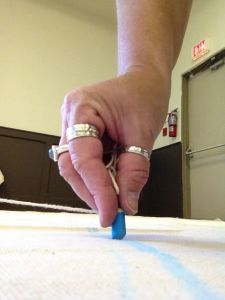 3. Once the dropcloths were sewn together, I drew the outline of the labyrinth with chalk. I started by measuring where my centre was and making a chalk mark there. Then I placed a paint can at the centre and tied a long string loosely on it to use as a giant compass/protractor. Tip: Make sure the string is loose enough on the can so that it rotates as you move around the circle.
3. Once the dropcloths were sewn together, I drew the outline of the labyrinth with chalk. I started by measuring where my centre was and making a chalk mark there. Then I placed a paint can at the centre and tied a long string loosely on it to use as a giant compass/protractor. Tip: Make sure the string is loose enough on the can so that it rotates as you move around the circle.
4. I wanted to make a 5-path version of the Chartres labyrinth. To figure out how wide my paths should be, I started by making the largest circle (to within a couple of inches of the edge of the canvas) and then making the centre circle (large enough that three people can comfortably stand in it). Then I measured the distance between the centre circle and the outside circle and divided it by 5. It came to 17.5 inches.
5. Shortening my string each time, I drew the concentric circles. 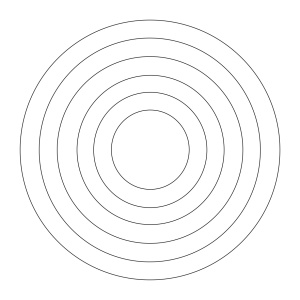
6. From there, it’s a matter of drawing the horizontal and vertical lines and then erasing the parts of the circle that aren’t needed. As you’ll see in the design I used, the horizontal and vertical lines all connect circles, so you need to pay attention to which of the circles you’re connecting, and then measure the same width as your path (17.5″ in my case) from that line to know how much of the circle to erase. Tip: The chalk marks are easy to brush away with a household brush (I used a pot scrubber).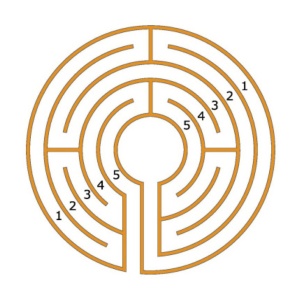
7. Once I had the chalk lines in place, I started painting. To keep it inexpensive, I used some leftover acrylic house paint for my lines, which worked great. I painted on the inside of each chalk line to keep it consistent.
8. For the width of the lines, I simply painted as wide as a small sponge brush. The edges of my lines are not very precise, since it’s hard to attain precision on fabric without driving yourself crazy, but I decided I was fine with that. It might have worked to put painters tape down, but that seemed like a lot of extra work to me (and I only had the space for a limited time) and I wasn’t sure how the tape would work around circles.
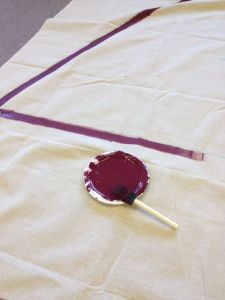 9. After the paint had dried, I decided to touch up the edges a bit with a thinner brush. It took a fair bit of extra time, but I liked the more solid line, so it was worth it.
9. After the paint had dried, I decided to touch up the edges a bit with a thinner brush. It took a fair bit of extra time, but I liked the more solid line, so it was worth it.
10. I let it dry for about 12 hours before folding it. It might have been a good idea to leave it longer, but the space was being used the next day so I needed to move it.
The hardest part of the whole process was all of the time spent (about 8 hours) crouching on the floor. By the end of it, I had a hard time unfolding my body! Stretching during my breaks helped, but I could have been more diligent.

















